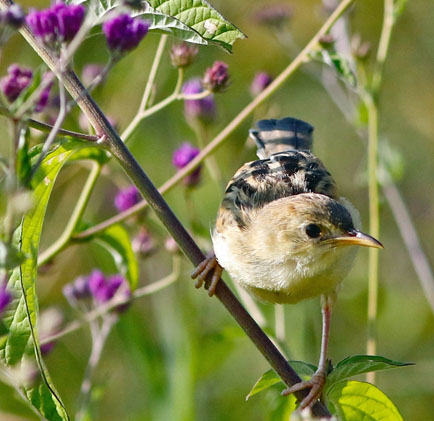
a web page by Don Roberson |
CISTICOLAS & ALLIES Cisticolidae Prinias, Apalises, Tailorbirds, Eremomelas, Camaropteras, Jerys, and cisticolid warblers |
|||||||
|
|||||||
The heart of cisticola distribution is in Africa. Many cisticolas resemble each other closely and they are usually best separated by their songs. These distinctive vocalizations gave rise to many English names, including: Singing, Chattering, Trilling, Bubbling, Tinkling, Wailing, Churring, Croaking, Piping, and Siffling cisticolas! This comparatively colorful one (left) is Winding Cisticola, which gives an insect-like mechanical trill that recalls the winding of an old-time clock. Those below show variations in size, bill, color, and song, from left to right: Whistling Cisticola (widespread, dark, big-billed), Boran Cisticola (very local, pale, small-billed), and Coastal Cisticola, a recent split from Winding in coastal east Africa, with its breeding plumage worn and washed-out. |
|||||||
|
|||||||
 |
|||||||
Other than the widespread Zitting Cisticola, the only the cisticolid species to reach Australasia is Golden-headed Cisticola (right, in a photo from Queensland, Australia). Considering the Cisticolidae as an entire family, the current 158 species are essentially 80% in Africa and 20% is Asia (with two reaching Australasia). Two species have populations in both Africa and Asia: Zitting Cisticola and Graceful Prinia Prinia gracilis (Nile Valley in Egypt, and the Middle East). |
|||||||
| Traditionally, the cisticolids were considered to be part of the huge Sylviidae family (Old World Warblers). Using DNA-DNA hybridization techniques, Sibley & Ahlquist (1990) considered them a family. The Birds of Africa series maintained them in Sylviidae (Vol. 5, Urban et al. 1997) but acknowledged that opinions were rapidly changing with new molecular techniques. The Handbook of the Birds of the World series was able to change course late in publication, and did offer a chapter on family Cisticolidae (Ryan 2006); it covered 145 species in 27 genera. Later, the eremomelas in genus Eremomola was added to the Cisticolidae, as was one genus that was not at all anticipated: two species of Micromacronus from the Philippines. These tiny passerines were initially called "Miniature Tit-Babbler" (e.g., Kennedy et al. 2000), then split as two "Minature-Babblers" (e.g., Collar 2006), and are now cisticolids (Oliveros et al. 2012) called Plumed-Warblers! The more recent molecular studies of the Cisticolidae include Nguembock et al. (2007) and Olsson et al. (2013), leading to the current make-up of this large family. Taxonomic papers on the Cisticolidae continue to be published and there are likely more species splits to come in the future (a few of those are mentioned herein). As just one new example, no world taxonomy has yet incorporated the proposed split of the Striated Prinia Prinia crinigera/Brown Prinia P. polychroa complex from its two species into five species in southeast Asia, as detailed in Alström et al. (2020). I've added the 3 extra prinias in this overview for statistical purposes, although the general taxonomy here is the current (2019) Clements' list. | |||||||
Update (2012): I'm now told that birds from this site were collected and proved to be C. dambo [Cloud-scraping Cisticola]. So it has a name after all . . . |
|||||||
|
|||||||
At the moment there are 27 species of prinias in genus Prinia, 16 in Asia, 10 in Africa, and one [Graceful Prinia P. gracilis] on both continents. A widespread African example is Tawny-flanked Prinia Prinia subflava, a widespread Africa species, was often merged with Plain Prinia P. inornatus of Asia in the past, but they are now split into their respective continental forms.
Two more Schistolais prinias are also in Africa, so that brings African prinias to 12 species. An example is White-chinned Prinia (below): it has a dark gray head and upperparts, a black mask and white chin, and has a slong tail. It lives in dense thickets, often along watercourses, in the Congo Basin from Nigeria to western Kenya. Black-chested Prinia (below) is a hefty, long-tailed prinia of southern Africa, with populations north to Angola and Zambia. It is one of those species for each the English name is not very useful. Populations in acacia savanna in South Africa have bold black breastbands on breeding males, but females and non-breeding males may lack a breastband. Worse, populations in arid scrub and village gardens in the northern parts of its range lack the "black chest," even in breeding males. This photo (below) from central Namibia shows a bird that entirely lacks a breastband. |
|||||||
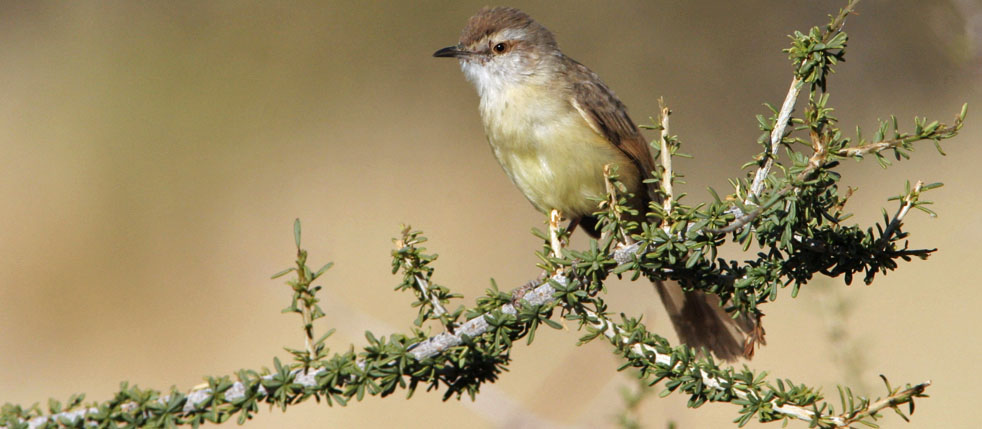 |
|||||||
 |
|||||||
Rufescent Prinia (right) is a gray-headed, white-bellied prinia with rufous wings and tail. It prefers grassy areas in open forest, and ranges from east India to Vietnam, and throughout southeast Asia. As cisticolids are primarily resident, a wide range of geographic variation has been noted within many species. Both Tawny-flanked Prinia (in Africa) and Plain Prinia (in Asia) have such geographic variations and thus have multiple subspecies. Plain Prinia is common from India to China and southeast Asia, and has populations (and distinctive subspecies) on Sri Lanka, Taiwan, and Java. It is possible that future studies will show some of those worthy of species-level status. |
|||||||
|
|||||||
 |
|||||||
The remaining cisticolids are from Africa. All 24 species of apalises [genus Apalis] are in Africa, as are two more apalises in genus Oreolais. Most apalises are colorful and patterned. Bar-throated Apalis (above) resides in a range of woodland and scrub habitats from east Africa (Kenya) to southern Africa. In South Africa is can be a bird of coastal scrub, as in this photo. It is small enough to sit on a hefty thorn, as shown in the photo. There are currently 19 named subspecies, some white-bellied, others yellow-bellied, and variously patterned above. This is race griseopyga, white below and blue-gray above. Among the apalises there is wide variety in habitats and plumages. Surely the most common is Yellow-breasted Apalis (below left) whose range includes most of sub-Sahara Africa (except tall forests). It likes open woods, scrub and thornscrub, and village gardens. In contrast, the range of Black-faced Apalis (below center; formerly "Mountain Masked Apalis") is restricted to wet montane forests in the Albertine Rift Mountains. Sharpe's Apalis (below right) is a canopy specialist in lowland and gallery forests of west Africa. This photo was taken from a canopy walkway 40m (130 ft) above the forest floor, among trees that are more than 50m (160 ft) in height. |
|||||||
|
|||||||
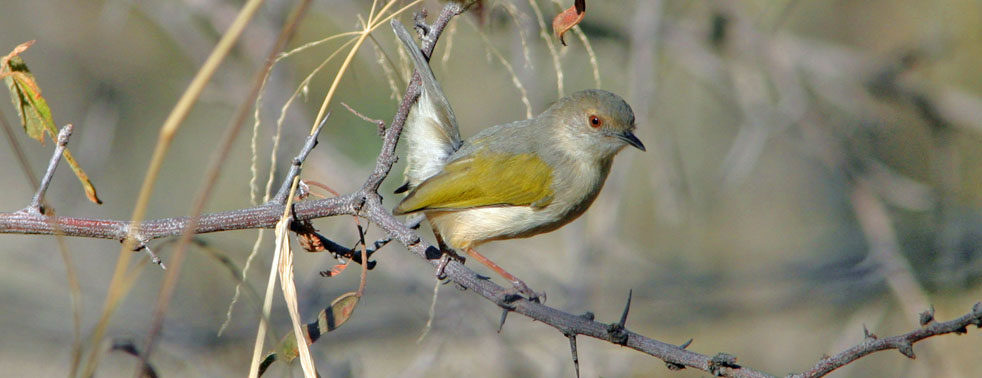 |
|||||||
Yellow-browed Camaroptera (left) is a short-tailed little bird with a hefty bill for its size. It prefers vines and tangles in open woodlands within its range across west and central Africa (but avoiding the deep forests of the Congo Basin). The diversity among 11 species of eremomela [genus Eremomela] is surprising and engaging. There are tiny, arboreal species, such as Senegal Eremomela (below left) of west Africa, that join feeding flocks of sunbirds in the crowns of flowering savanna trees. There are heavier birds in acacia woods and riverine thornscrub, like the pale-eyed Burnt-necked Eremomela (below right), that occur in a belt of habitat across central Africa from Namibia to Mozambique. And there are rare and local residents of lowland rainforest, such as Turner's Eremomela Eremomela turneri, that occurs only in very local forests in D.R. Congo and in the Kakamega Forest of Kenya. |
|||||||
|
|||||||
 |
|||||||
While many cisticolids are reasonable common, there are some very rare and local species, such as Kabobo Apalis Apalis kaboboensis, which is restricted to montane bamboo patches on Mt. Kabobo in southeast D.R. Congo — talk about a bird that is going to be hard to get! [in fact, currently, eBird has not photos in its account]. Some species are limited to single islands, including Sao Tome Prinia on the island of Såo Tomé in the Gulf of Guinea, and Socotra Warbler Incana incana, another monotypic genus, endemic to its namesake island. There are nine other very rare members of the Cisticolidae detailed in Collar et al. (1994). One of those is the critically endangered Long-billed Tailorbird Artisornis moreaui, restricted to very local sites in the East Usambara Mountains of northeast Tanzania, and the Njesi Plateau, in northern Mozambique. The Tanzanian population has been estimated at fewer than 250 birds (McEntee et al. 2005). Rita and I got some nice views in 2018, and tape-recorded its song, but the dense thickets of its habitat produced unusable shots of a fuzzy bird facing away . . . [The other tailorbird in Africa is African Tailorbird Artisornis metopia, reasonably common in the "eastern arc" mountains of Tanzania and Malawi.] The cisticolid with the intriguing name of Mrs. Moreau's Warbler Scepomycter winifredae lives in the dense undergrowth of a couple of mountain ranges in eastern Tanzania. It is a small gray warbler with a striking rufous head. Reginald Moreau first collected it in 1938, and gave it a scientific name in honor of his wife Winifred (Moreau 1938, 1946). Just this century, a new population of a similar warbler was discovered in the isolated Rubeho-Ukaguru Mts. of eastern Tanzania, which was described as a new species on genetic grounds (Rubeho Warbler S. rubehoensis; Bowie et al. 2009). Some world checklists have accepted this split; others have not, awaiting further evidence. In any event, it goes to show just how little we know about quite a number of the world's cisticolids. In fact, as I post this is 2021, I am aware that there are two as-yet-unnamed cisticolas in the Kilombero swamp area of southern Tanzania, currently known in eBird as "Kilombero Cisticola" [unnamed taxon] and "White-tailed Cisticola" [unnamed taxon]. We are actually going there this summer, and if photos are obtained, this will need another update. . . . |
|||||||
Here (left) is a fledgling Winding Cisticola, in bright fresh plumage and a gular flange. It is the same species featured in the first photo atop this page. Cisticolas differ as much between fresh and worn plumages as they do between species. So, as a whole, the Cisticolidae can be a confusing set of birds. Only recently has really good artwork is finally been available in African field guides (e.g, Zimmerman et al. 1996). Some very useful i.d. literature has been published in the African journal Scopus and other African magazines. I used some of the early articles (from the late 1970s) with success in the 1980s, and I'm sure there are many more now. Although the huge number of cisticolas and allies can be intimidating, I've begun to think of them as I do North America sparrows. Many beginning birdwatchers find sparrows intimidating when they flip through a field guide. Yet it turns out that most sparrows are quite easy. The majority are resident is specific habitats, and one simply needs to learn those habitats (and the songs). Resident species do not generate vagrants, as do migrants, so there is no point in trying to find resident birds out of range. Cisticolids, like most American sparrows, are almost entirely restricted to specific habitats. "Find the habitat," one old friend used to say, "and then you'll find the bird." Words of wisdom. |
|||||||
Photos: The Winding Cisticola Cisticola marginatus was at Ngorongoro Crater, Tanzania, on 9 Aug 2002. The Whistling Cisticola Cisticola lateralis was at Kalakpa, Ghana, on 29 Nov 2013. The Boran Cisticola Cisticola bodessa was at a stake-out spot in a patch of scrub at the Isiaolo-Meru junction on the Nanyuki-Isialo highway in northern Kenya on 12 Nov 1981. The singing Coastal Cisticola Cisticola haematocephalus was at Mkomazi, Tanzania, on 6 June 2018. The Zitting Cisticola Cisticola juncidis, of the "eastern" Group, was in the Candaba marsh, Luzon, Philippines, on 30 Dec 2005. The Golden-headed Cisticola Cisticola exilis was at Lake Galletly, Queensland, Australia, on 3 Sep 2016. The Rattling Cisticola Cisticola chiniana was in Tarangire, Tanzania, on 9 June 2018. The Cloud-scraping Cisticola Cisticola dambo was in extreme southeastern Gabon on 11 July 1996. The Chirping Cisticola Cisticola pipiens was in the Okavango Delta, Botswana, on 24 July 2005. The Red-headed Cisticola Cisticola subrufacapilla was at Jonker Dam, near Cape Town, South Africa, on 3 July 2005. The Madagascar Cisticola Cisticola cherinus was north of Tulear, Madagascar, on 20 Nov 1992. The Desert Cisticola Cisticola aridulus was in Tarangire NP, Tanzania, in 8 June 2018. The Rock-loving Cisticola Cisticola aberrans was in the Tongo Hills, Ghana, on 14 Dec 2013. The White-chinned Prinia Schistolais leucopogon was in the Kakamega Forest, Kenya, on 18 Nov 1981. The Såo Tomé Prinia Prinia molleri was in the garden of the Bua Vista Hotel, well up the central volcano on Såo Tomé island, Såo Tomé e Príncipe, on 19 July 1996. The Black-chested Prinia Prinia flavicans was at Grosse Spitzkoppe Nature Reserve, Namibia, on 17 July 2005. The displaying Black-throated Prinia Prinia atrogularis was was below Trongsa, Bhutan, on 26 Mar 2019. The Rufescent Prinia Prinia rufescens was at Sab Sadao Ranger Station, Thailand, on 27 Dec 2012. The Dark-necked Tailorbird Orthotomus atrogularis was near Kaziranga NP, Assam, India, on 14 Mar 2019. The Common Jery Neomixis tenella was at Ifaty, Madagascar, on 20 Nov 1992. The Bar-throated Apalis Apalis thoracica was in West Coast NP, South Africa, on 5 July 2005. The Yellow-breasted Apalis Apalis flavida was at Lake Baringo, Kenya, on 16 Nov 1981. The Black-faced Apalis Apalis personata was at Mubwindi Swamp, Bwindi-Impenetrable NP, Uganda, on 18 July 2002. The Sharpe's Apalis Apalis sharpii was photographed from the canopy walkway at Kakum NP, Ghana, on 2 Dec 2013. The Gray-backed Camaroptera Camaroptera brachyura was at Waterberg Plateau NP, Namibia, on 26 July 2005. The Yellow-browed Camaroptera Camaroptera superciliaris was at Antwikwaa, Ghana, on 3 Dec 2013. The Senegal Eremomola Eremomola pusilla was in Mole NP, Ghana, on 13 Dec 2013. The Burnt-necked Eremomola Eremomola usticollis was at Daan Viljoen Game Park, Namibia, on 28 July 2005. The Rufous-eared Warbler Malcorus pectoralis was near Brandvlei, South Africa, on 7 July 2005. The Namaqua Warbler Phragmacia substriata was at Augrabies Falls NP, South Africa, on 9 July 2005. The fledgling Winding Cisticola Cisticola marginatus was Tarangire NP, Tanzania, on 8 June 2018.
Bibliographic note: There is no "family book" for the Cisticolidae but a good introduction is in Ryan (2006). Previously, before Handbook of the Birds of the World published a chapter on cisticolids, the most useful overall summary to date was in Urban et al. (1997), at least as to African species. Literature cited:
|
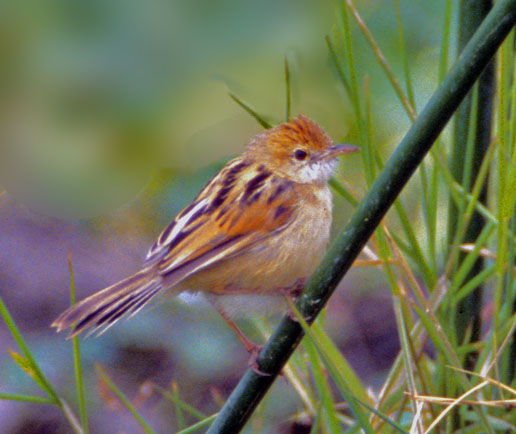 The Cisticolidae are a large family of small Old World songbirds. Many are birds of open habitats such as grassland, scrub, or desert. Nearly a third of them (49 species) are Cisticolas (pronounced sis-TIC-olas) in genus Cisticola. Molecular studies have enlarged the family to include other mostly African groups — apalises, camaropteras, eremomelas, various "warblers" — and some Asian birds like prinias and (most) tailorbirds.
The Cisticolidae are a large family of small Old World songbirds. Many are birds of open habitats such as grassland, scrub, or desert. Nearly a third of them (49 species) are Cisticolas (pronounced sis-TIC-olas) in genus Cisticola. Molecular studies have enlarged the family to include other mostly African groups — apalises, camaropteras, eremomelas, various "warblers" — and some Asian birds like prinias and (most) tailorbirds.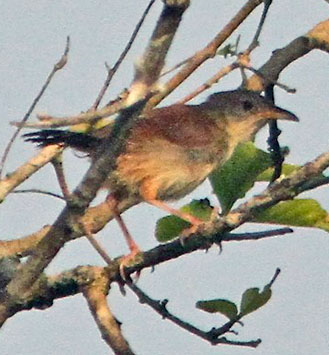


 The most widespread cisticola is Zitting Cisticola (above, a photo from the Philippines). It is a small cisticola with streaked upperparts that ranges from southern Europe and north Africa to Japan and Australasia. There are currently 17 named subspecies in 4 "groups" over its extensive range; variations in the pitch and speed of vocalization might suggest that some could prove to be different species. The male's standard song, though, given from a perch or (often) in flight, is a fact, monotonous string of "zip" or "zit" notes.
The most widespread cisticola is Zitting Cisticola (above, a photo from the Philippines). It is a small cisticola with streaked upperparts that ranges from southern Europe and north Africa to Japan and Australasia. There are currently 17 named subspecies in 4 "groups" over its extensive range; variations in the pitch and speed of vocalization might suggest that some could prove to be different species. The male's standard song, though, given from a perch or (often) in flight, is a fact, monotonous string of "zip" or "zit" notes.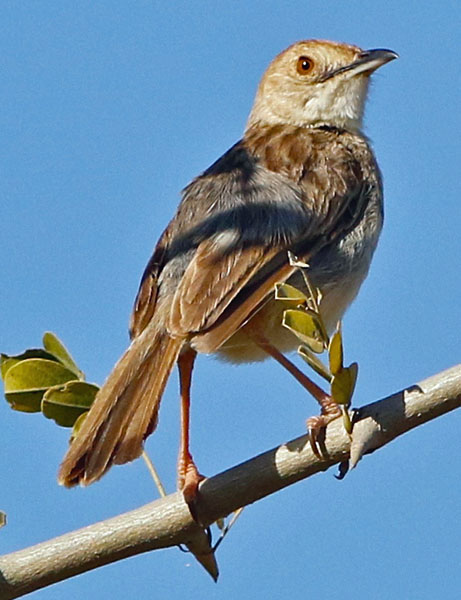 This (left) is Rattling Cisticola. It is a common species with a large range in central and eastern Africa, with currently 17 subspecies. It is fairly large, usually quite plain and gray (in most subspecies), and has a long graduated tail. It simple territorial song is a common sound in Tarangire NP, Tanzania, where this photo was taken. Other cisticolas are local and little-known.
This (left) is Rattling Cisticola. It is a common species with a large range in central and eastern Africa, with currently 17 subspecies. It is fairly large, usually quite plain and gray (in most subspecies), and has a long graduated tail. It simple territorial song is a common sound in Tarangire NP, Tanzania, where this photo was taken. Other cisticolas are local and little-known. 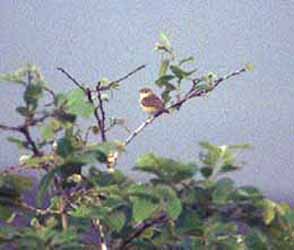



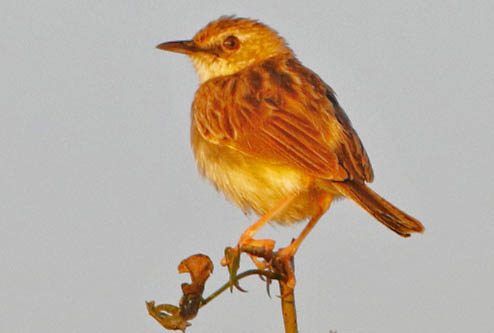

 Other prinias are quite local. Sao Tome Prinia (right) is endemic to São Tomé, in the Gulf of Guinea, off west Africa. It is an engaging and curious species. It is conspicuous because of its odd habit of flicking its wings up above its back constantly. Like other prinias, it has long legs and can straddle separated perches easily.
Other prinias are quite local. Sao Tome Prinia (right) is endemic to São Tomé, in the Gulf of Guinea, off west Africa. It is an engaging and curious species. It is conspicuous because of its odd habit of flicking its wings up above its back constantly. Like other prinias, it has long legs and can straddle separated perches easily.
 Asian prinias include lowland and upland species. Black-throated Prinia (above) lives in the Himalayas and other montane habitats from 900-2800m [2900-9200' elev.]. This singing male in montane Bhutan is performing a display with out-stretched wings and vibrating tail; I don't see mention of this display in the brief literature consulted.
Asian prinias include lowland and upland species. Black-throated Prinia (above) lives in the Himalayas and other montane habitats from 900-2800m [2900-9200' elev.]. This singing male in montane Bhutan is performing a display with out-stretched wings and vibrating tail; I don't see mention of this display in the brief literature consulted. 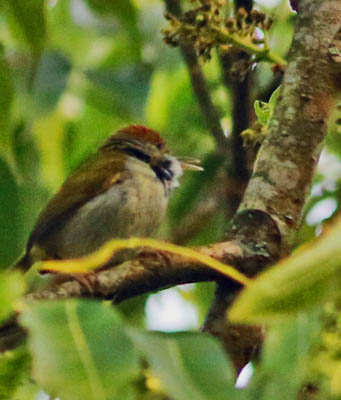
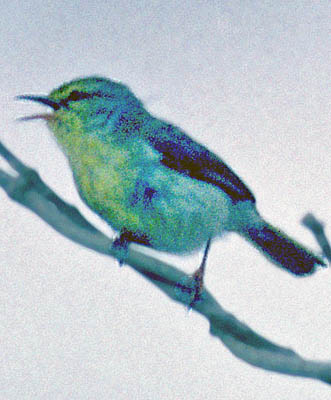

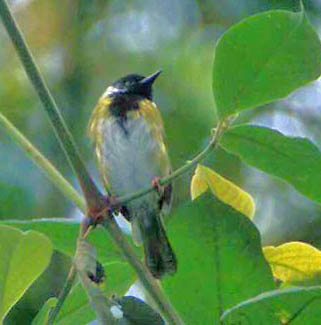
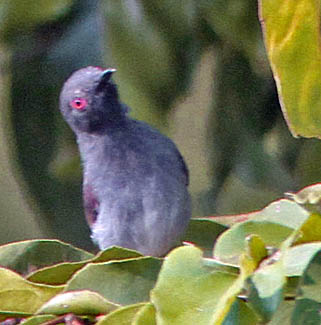
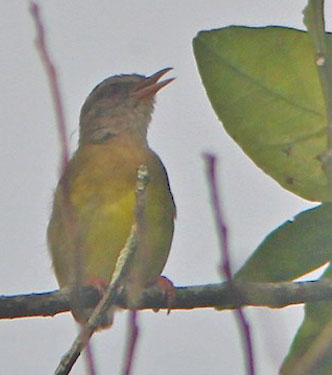 There are four species of camaroptera [genus Camaroptera] but one is so common and widespread in open woodlands and scrubby country that it is among one of the best know little birds of Africa. About half of English-speaking residents in Africa call it Gray-backed Camaroptera, and the other half call it Green-backed Camaroptera. This photo is from southwest Africa, where it is called Gray-backed Camaroptera (above). Currently, there are 11 subspecies in the gray-backed “brevicaudata group” — ranging south of the Sahara from west to east Africa, and south to Namibia and Botswana — and five races in the green-backed “brachyura group” that ranges from coastal east Africa to eastern South Africa. These groups have often been treated as separate species, but calls, displays, and songs are similar Urban et al. 1997). The male's song, given all year, is a penetrating “kwit-kwit-kwit-kwit,” like two stones knocking together, or a bubbling burst of notes. The mewing call, like a bleating lamb, is heard often. It is a curious little bird, and often cocks its short tail up.
There are four species of camaroptera [genus Camaroptera] but one is so common and widespread in open woodlands and scrubby country that it is among one of the best know little birds of Africa. About half of English-speaking residents in Africa call it Gray-backed Camaroptera, and the other half call it Green-backed Camaroptera. This photo is from southwest Africa, where it is called Gray-backed Camaroptera (above). Currently, there are 11 subspecies in the gray-backed “brevicaudata group” — ranging south of the Sahara from west to east Africa, and south to Namibia and Botswana — and five races in the green-backed “brachyura group” that ranges from coastal east Africa to eastern South Africa. These groups have often been treated as separate species, but calls, displays, and songs are similar Urban et al. 1997). The male's song, given all year, is a penetrating “kwit-kwit-kwit-kwit,” like two stones knocking together, or a bubbling burst of notes. The mewing call, like a bleating lamb, is heard often. It is a curious little bird, and often cocks its short tail up.
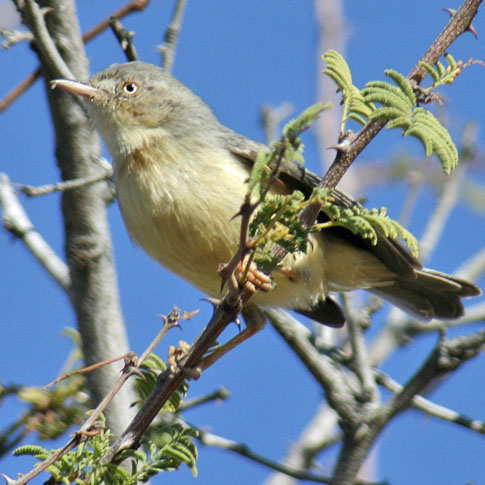
 Finally, among the 158 members of family Cisticolidae (and counting), are various warblers, wren-warblers, rufous-warblers, longtails, and tailorbirds in 16 genera. I'll highlight just a handful. Rufous-eared Warbler (above) is the only member of the genus Malcorus. It is mostly resident in Namibia, Botswana, and western South Africa, where it resides in Karoo scrub or desert grasslands with small bushes. It may move short distances in response to rain (or the lack thereof; Ryan 2006). Namaqua Warbler (right) is the lone member of genus Phragmacia. It, too, is restricted to semi-arid Karoo habitat, where it is a specialist of reedbeds and thorn-tree thickets. It is generally a skulker except when sitting up and singing a loud trill (as this one is doing). South Africans often call it the "Namaqua Prinia."
Finally, among the 158 members of family Cisticolidae (and counting), are various warblers, wren-warblers, rufous-warblers, longtails, and tailorbirds in 16 genera. I'll highlight just a handful. Rufous-eared Warbler (above) is the only member of the genus Malcorus. It is mostly resident in Namibia, Botswana, and western South Africa, where it resides in Karoo scrub or desert grasslands with small bushes. It may move short distances in response to rain (or the lack thereof; Ryan 2006). Namaqua Warbler (right) is the lone member of genus Phragmacia. It, too, is restricted to semi-arid Karoo habitat, where it is a specialist of reedbeds and thorn-tree thickets. It is generally a skulker except when sitting up and singing a loud trill (as this one is doing). South Africans often call it the "Namaqua Prinia."